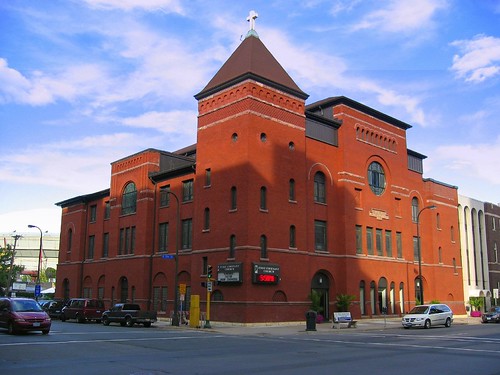Driven by young professionals and empty-nesters, high-rise apartments are sprouting up across the country.
It would be hard to confuse Minneapolis for Manhattan, but the Nic on Fifth might just make it possible.
The Nic on Fifth is a new 26-story apartment building that sits smack on a light-rail stop and boasts amenities like a pool deck and a private dog park. From the top floor you can see miles of the Mississippi River and the field where the Minnesota Twins play.
When the building opens in August, it will be one of two new rental towers that are stretching this city's skyline and — with monthly rents ranging from $1,450 for a studio to $9,000 for a penthouse — charging prices rarely seen in the Twin Cities.
Minneapolis isn't the only place building upward. While the U.S. housing market as a whole may still be creeping back from recession, downtowns around the country are seeing a veritable boom in high-rise apartment buildings.
This year, some 74 rental towers are on pace to be completed, and there are 81 on the books for 2015 — the highest number since at least the 1970s, according to Axiometrics, a Dallas apartment-research firm that defines a tower as 15 stories or more. At the same time, strong apartment rents and sluggish demand for office space have resulted in some high-rise buildings being converted to apartments.
Overall, the growth has been largest in denser and pricier markets like San Francisco, New York and Chicago. But in percentage terms, the increase has been most dramatic in smaller cities like Minneapolis, which is building apartments, including high-rise apartment buildings, at the fastest pace in decades.
In Austin, Texas, the seven apartment towers that will be completed between 2013 and 2015 compares with four from 2005 to 2012, according to Axiometrics. Houston has eight apartment towers set to be completed in 2014 and 2015, compared with six from 2005 to 2012.
This past week in Kansas City, Mo., developers broke ground on the One Light building, which will be 25 stories tall and the first new apartment tower in the city's downtown since 1976.
"It's the Manhattanization of America and it's happening in cities that never had rental high rises," says Mark Humphreys, chief executive of Dallas-based Humphreys & Partners Architects, which specializes in apartments and condominiums.
The growth in new rental towers — which are usually woven into downtown office centers — is being driven largely by young professionals starting their careers, along with empty-nesters who are in some cases downsizing from bigger homes in the suburbs. Together, they are helping downtowns evolve from places centered mostly on working and entertainment to more complete neighborhoods, with grocery stores, community centers and community services.
Minneapolis resident Dan Born, who moved to the city from San Francisco to work for a software firm called Code42, pays about $1,800 a month for a one-bedroom apartment in a building close to downtown. Mr. Born, 29, said he travels a lot for work and doesn't know how long he will be in Minneapolis, so he doesn't want to be tied to a property. He also likes being close to downtown, he said.
"At some point I'm going to have to bite the bullet [and buy a home]," Mr. Born said. "But I don't feel like I'm stable enough for that investment,"
The influx of new residents has brought Dan Collison's church back from the brink. He is pastor of First Covenant Church, which has been in downtown Minneapolis since the late 1800s.
Over the past half century, as parishioners fled to the suburbs, Sunday attendance dwindled to as low as 50. Today, helped by more people living downtown, Sunday attendance has jumped to around 300, Mr. Collison said.

Rising demand for rental apartments across the country reflects a confluence of trends. Mortgage-qualificationstandards are easing, but home loans remain hard to get for people with low credit scores. With most Americans seeing slow growth in their paychecks, many who want to buy a home either can't get a loan or are still saving for a down payment.
As a result, rents are setting new records. Despite the new supply, Minneapolis's downtown rents rose 9 percent last year, and the vacancy rate was a 4 percent at the end of 2013, according to Marquette Advisors, a real estate research firm. That is up from 1.9 percent in 2012, but the city has added close to 1,000 units over the year. With rents going up and only a limited amount of space, developers are building skyward.
For developers like Minneapolis-based Opus Group, the apartment boom has helped to offset a weak market for high-rise office construction. Tim Murnane, chief executive, notes that apartment buildings have accounted for about half of the company's business over the past three years, compared with just a fraction of that in previous years.
The risk for developers is that they overdo it, building too may apartments and causing rents to fall. But with thousands of new residences now in the area, the evolution of downtown is likely to continue.
Steve Cramer, president of the Minneapolis Downtown Council, notes that in the late 1990s he was appointed by the city's then-mayor to head Minneapolis's community redevelopment agency. One of the group's goals was to get a single grocery store to open downtown, but it failed.
"We could not offer enough subsidies," he said. "Today there are three within a mile of each other, and it's because all these people are living downtown."
Source: MSNRealEstate.com, Article By Conor Dougherty, The Wall Street Journal

